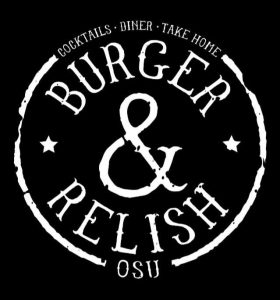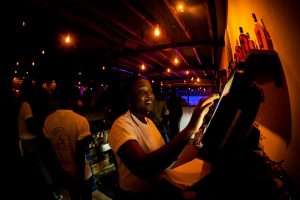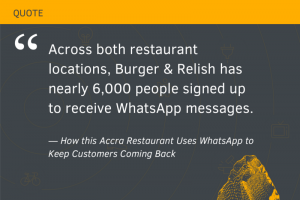Burger & Relish is a popular American diner-style restaurant with two locations in Accra, Ghana — one in Osu (a commercial district), and another in East Legon (a quiet, upscale neighbourhood).

In this exclusive article, Sean Burrowes, General Manager of Burger & Relish’s East Legon location, takes us deep into how his restaurant uses WhatsApp to keep his customers coming back.

Think of WhatsApp as a customer service channel for your best clients, *not* a mass advertising medium
WhatsApp is undeniably one of the most dominant forms of communication in the emerging world, and Accra is no different. Everyone uses WhatsApp — it transcends age, gender, and socio-economic status.
Because WhatsApp is so pervasive, marketers have been quick to attempt to use it to push their wares, but Burrowes recommends that a better approach is to think of the app as a direct line to your best existing customers.
“I think people are a bit fatigued with receiving marketing messages via WhatsApp,” says Burrowes. “A year or so ago, few companies were sending WhatsApp messages, but a lot businesses are doing so now, most of them badly, with the result that you’re starting to see less engagement.”
A more effective WhatsApp strategy, Sean suggests, is to think of WhatsApp as a direct line to your best, most engaged existing customers.
“When I send out a WhatsApp broadcast, I often get replies back. Sometimes they want to know if a certain dish is still on a menu, and this is a great opportunity to educate about our offerings and even upsell them on new ones. Other times, they want to flag an important issue they were uncomfortable mentioning in person, and that becomes an opportunity to address a customer service issue and improve our operations. We’ve found WhatsApp to be great as a customer support tool.”

To get people to opt-in to receiving WhatsApp messages, tap into their FOMO (fear of missing out)
Across both restaurant locations, Burger & Relish has nearly 6000 people signed up to receive WhatsApp messages — about 4000 phone numbers for their Osu location collected over 2 years, and about 1,500 phone numbers for their East Legon restaurant, collected in about 4 months.

To acquire these phone numbers, Sean and his team first get a sense of whether the guest is clearly enjoying themselves. If so, they mention events that’ll be happening at the restaurant throughout the week, and ask if the guest would like to receive a reminder about future events via WhatsApp.
“We have multiple events at Burger & Relish during the week, so we use that as a hook to pique people’s interest. I train my waitstaff to collect numbers, but there’s only a light script, otherwise the delivery will be too robotic. Each team member is invited to bring their own style to it.”
Waitstaff are held accountable for growing the restaurant’s WhatsApp phone number database.
“Each waiter has a sheet where they list the numbers they’ve collected that day, and I make sure to review it so that my team knows that this is something that is important, and that’s a core part of their responsibility.”
Segment your WhatsApp Broadcast Lists
At the end of each day, the new numbers collected by the team is entered into WhatsApp Broadcast Lists on a company phone.


These lists are very intentionally organized.
“What most other companies do is that they just dump numbers into lists. What we do at Burger & Relish is that we add their number to a variety of named segments. For example, a guest who came with kids will get added to the Families Lists, young adults and college folks get added to Student Lists, etc. This helps us tailor messages to specific target groups in a way ensures that the message resonates.”
ALSO READ: Gold Coast Fund Management begins payment of customers’ investments
Create a distinct brand voice and tone
Every company has a personality that reflects their target audience, and Sean recommends ensuring that the WhatsApp messages are similarly on-brand.
“There’s actually a difference between how the two Burger & Relish restaurants talk to their respective WhatsApp lists. Our Osu location is very popular with expats, whereas most of our clientele in East Legon is a Ghanaian audience that usually comes to our restaurant to celebrate a specific event. This definitely influences my tone when messaging our East Legon customers, all the way down to the kinds of pop-culture references I make.”
The timing of messages is important
Sean recommends thinking carefully about when your target audience is most likely available to engage with your message.
“I send out messages at one of three times during the day: around 7 AM (so that it’s one of the first things people see when they wake up), around noon (so they see it during their lunch break), or somewhere between 5 to 7 PM (when people are deciding where to go eat out). I find that messages sent during times when people are likely to be busy result in fewer responses.”
Train your audience to respond
Businesses get the greatest return on investment when customers think of WhatsApp as a two-way communication channel. To get them there, it’s important to “train” them to respond to messages.
“Occasionally, I’ll do a small giveaway (eg. a free soft drink with any purchase) where people need to reply via WhatsApp to qualify for the deal. I find that this is a great way of getting people to reply for the first time, and after that, they start to think of the Burger & Relish WhatsApp not as mass advertiser, but a direct customer service line to their friends at the restaurant.”
Author: Emmanuel Quartey
Article originally appeared on The Flint; a magazine for people building businesses and projects in Africa, who want simple answers about how technology can help them meet their goals.










